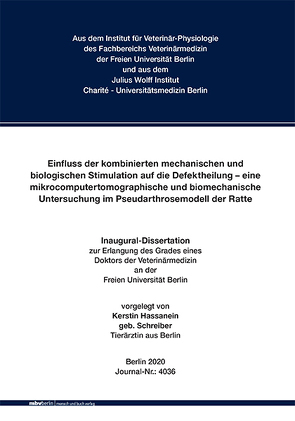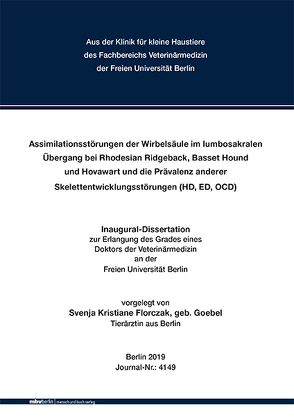
Influence of combined mechanical and biological stimulation on defect healing – a microcomputed tomographic and biomechanical study of critical-sized bone defects in rats
Generally it is known that the mechanical environment (stiffness of stabilization measures) is significant for the healing success of a fracture (Histings et al., 2010; Bartnikowski et al., 2017; Claes, 2017; Glatt et al., 2017). Under which biomechanical conditions a fast and efficient fracture healing would be achievable has been the subject of intensive research for some time (Claes, 2017).
Additionally, several studies have shown the positive effect of BMP-2 for bone healing (Nauth et al., 2011; Wildemann et al., 2011). Extended knowledge of the impact of the dosing of growth factors and how much their interaction with mechanical stress can influence the efficiency of bone regeneration show possible future strategies for cases in which a bony bridging of the fracture gap has not yet been achieved. (Schmidt-Bleek & Willie et al., 2016).
The aim of this work was to analyze the effects of varying fixation stiffness in combination with BMP-2 treatment in a critical sized defect (CSD) in a rat.
32 female Sprague Dawley rats, 12 weeks old, were randomized in four groups each of eight animals. Three experimental groups received a standardised critical 5 mm defect, 5μg rhBMP-2 was loaded on a absorbable collagen sponge and placed into the defect and stabilized with a flexible, semi-ride or rigide connecting element of the external fixator. The control group (1 mm osteotomy) mimicked an uncritical healing and was stabilized with the rigid fixator. All groups were analysed by in vivo micro-CT, perforrmed at day 10, 21 and 42 post-operation. At day 42 the rats were sacrificed and the osteomised left femora (including external fixator) were harvested. Additionally, the right intact femur of seven animals was harvested randomizedly. In the following, all samples were analysed by biomechanical in vitro testing for torsional stiffness and maximal torque value.
The initial healing process of the stiffness groups was found with comparable tissue structure in the descriptive micro-CT. At day 10, in all stiffness groups moderate bone formation was detected along the periosteal defect site that was not sufficient for defect bridging. However, among the other stiffness groups, upon semi-rigid fixation, a tendency towards a higher level of mineralization was still found, which correlates with the largest statistically not significant TV-, BV- und TMC-values. Whereas the flexible group showed the lowest TV-value.
On day 21 defects were bridged with bone tissue in all stiffness groups. As a result of the beginning maturing process, the micro-CT showed reabsorption processes. Delayed healing was found upon flexible fixation towards the other stiffness groups. Also a defect site with calcified and mineralized callus was found.
On day 42, the flexible group showed significantly higher values for TV, BV, BV/TV and TMC, whereas the semi-rigid group showed the smallest of these values. This was seen by a defect site filled with mineralised callus upon flexible fixation, whereas the
other stiffness groups had already shown reabsorption processes with rebuilding of the medullary cavitiy. Regarding TMD, the semi-rigid group showed the highest value, while flexible group showed the lowest value, but without any significance. The rigid group and the semi-rigid group showed a reduction of the total volume (TV) and also lower BV- and TMC-values as the flexible group - but also a lower TMD-value as the semi-rigid group. This leads to the presumption of a delayed maturing process.
By using biomechanical in vitro tests, the semi-rigid group showed nearly equivalent results respective the torsional stiffness and the maximal torque at failure between the rigid and the flexible group.
This study has shown that the BMP-2-stimulated defect healing is mechano-sensitive. Although marginal statistically significant differences in biomechanical and micro-CT results have been found, an accelerated healing process has been demonstraded upon semi-rigide and rigide group contrary to the flexible fixation – indicating a delayed boost of bone formation, whereas other stiffness groups had already shown reabsorption processes with rebuilding of the medullary cavitiy. This leads to the insight that the modulation of the mechanical environment of the critical defect has an impact on the healing process, despite the same BMP-2-treatment.
Aktualisiert: 2021-04-16
> findR *

Assimilation Disorders of the Vertebral Column at the Lumbosacral Transition in the Rhodesian Ridgeback, Basset Hound and Hovawart and the Prevalence of Other Skeletal Developmental Disorders (HD, ED, OCD)
In the present study, the prevalence of lumbosacral transitional vertebrae (LTV) in three dog breeds (Rhodesian Ridgeback, Basset Hound and Hovawart) and a possible disposition of these breeds for hip dysplasia were examined by means of radiography in ventrodorsal projection. The radiographs were obtained from HD (hip dysplasia) screening examinations and were retrospectively evaluated in relation to LTV. The HD findings were recorded from the case report forms. HD was diagnosed according to the guidelines of the FCI (Federation Cynologique International). For the breed Rhodesian Ridgeback, additionally, the findings concerning elbow joint dysplasia (ED) and osteochondrosis dissecans (OCD) of the humeral head according to the IEWG (International Elbow Working Group) guidelines were taken from the finding sheets and correlated with LTV for the first time in this study.
In total, HD X-rays of N=2402 Rhodesian Ridgebacks, N=249 Basset Hounds and N=116 Hovawarts were available. For N=1815 of the Rhodesian Ridgebacks, radiographs of the elbow joints in the basic image pair (craniocaudal and mediolateral) and N=1788 of the shoulder joints in the medio-lateral projection were available. A total of 154 radiographs were not considered in the context of this evaluation, due to inadequate patient positioning and/or X-ray technique, overlays of the area of interest with faeces or similar disqualifiers in other locations. 427 radiographs went missing, because they had to be sent to the supervising reviewer, but were not returned.
LTV were detected in 6.7% (159/2377) of the dogs in the study population. Rhodesian Ridgebacks were affected in 7.4% (140/2012), Basset Hounds in 2.8% (7/249) and Hovawarts in 2.6% (3/116) of cases. Symmetric LTV were detected in 4.6% (n=109) of the dogs, of which 5.0% (101/2012) were Rhodesian Ridgebacks, 2.0% (5/249) Basset Hounds and 2.6 % (3/116) Hovawarts. The prevalence of asymmetric LTV in this study was 2.1% (50/2012), of which 2.4% (48/2012) where found in Rhodesian Ridgebacks, 0.8% (2/249) in Basset Hounds and none in Hovawarts. A sex disposition could not be proven for any of the breeds.
The LTV findings were correlated with those with HD. For LTV and HD, in general, there was no significant correlation, neither for the entire study population, nor for the individual breeds. For the Rhodesian Ridgeback, the correlation between LTV (149/2012) and higher HD-grades (non-eligible for breeding = HD-grade C, D and E) was statistically significant (p<0,05), likewise for the asymmetric LTV (48/2012) and the HD-grades C, D and E (p <0.05).
There were no significant correlations for other morphological abnormalities in the lumbosacral area, such as a differing number of sacral vertebrae (28/1833) or an altered intervertebral space L7/S1 (141/1825) in the entire study population or in the individual breeds.
The correlation of LTV with disorders from the elbow joint dysplasia complex (ED) and osteochondritis dissecans (OCD) of the humeral head in Rhodesian Ridgebacks were statistically significant (ED 26/1815, FPC 23/1826): for LTV and ED (p <0.01) and its degrees of severity (p <0,05) and LTV and fragmented processus coronoideus (FPC) (p <0.05) and its degrees of severity (p <0.05). The correlations were not significant for OCD of the elbow joint, the isolated processus anconaeus ulnae (IPA), likewise for OCD of the shoulder joint. An intracondylar OCD / incomplete ossification of the humeral condyle (IOHC) did not occur in the study population.
HD also correlated significantly with ED (p <0.001) and its degrees of severity (p <0.001), likewise with FPC (p <0.001) and its degrees of severity (p <0.001). In addition, the correlation between HD and osteochondritis dissecans (OCD) of the elbow joint was significant (p <0.05). The correlations were not statistically significant for the other diseases.
In summary, the results of this study support the literature references that demonstrated positive correlations between LTV and HD. In this study, however, the relationships were only significant for the severe HD forms, as KOMSTA et al. (2015) showed. The significant correlations between HD and ED observed in previous studies could also be confirmed with this work. The correlations of LTV and ED, and OCD, which were also statistically significant, were investigated for the first time in this study.
Aktualisiert: 2019-12-31
> findR *
MEHR ANZEIGEN
Bücher zum Thema X radiation
Sie suchen ein Buch über X radiation? Bei Buch findr finden Sie eine große Auswahl Bücher zum
Thema X radiation. Entdecken Sie neue Bücher oder Klassiker für Sie selbst oder zum Verschenken. Buch findr
hat zahlreiche Bücher zum Thema X radiation im Sortiment. Nehmen Sie sich Zeit zum Stöbern und finden Sie das
passende Buch für Ihr Lesevergnügen. Stöbern Sie durch unser Angebot und finden Sie aus unserer großen Auswahl das
Buch, das Ihnen zusagt. Bei Buch findr finden Sie Romane, Ratgeber, wissenschaftliche und populärwissenschaftliche
Bücher uvm. Bestellen Sie Ihr Buch zum Thema X radiation einfach online und lassen Sie es sich bequem nach
Hause schicken. Wir wünschen Ihnen schöne und entspannte Lesemomente mit Ihrem Buch.
X radiation - Große Auswahl Bücher bei Buch findr
Bei uns finden Sie Bücher beliebter Autoren, Neuerscheinungen, Bestseller genauso wie alte Schätze. Bücher zum
Thema X radiation, die Ihre Fantasie anregen und Bücher, die Sie weiterbilden und Ihnen wissenschaftliche
Fakten vermitteln. Ganz nach Ihrem Geschmack ist das passende Buch für Sie dabei. Finden Sie eine große Auswahl
Bücher verschiedenster Genres, Verlage, Autoren bei Buchfindr:
Sie haben viele Möglichkeiten bei Buch findr die passenden Bücher für Ihr Lesevergnügen zu entdecken. Nutzen Sie
unsere Suchfunktionen, um zu stöbern und für Sie interessante Bücher in den unterschiedlichen Genres und Kategorien
zu finden. Unter X radiation und weitere Themen und Kategorien finden Sie schnell und einfach eine Auflistung
thematisch passender Bücher. Probieren Sie es aus, legen Sie jetzt los! Ihrem Lesevergnügen steht nichts im Wege.
Nutzen Sie die Vorteile Ihre Bücher online zu kaufen und bekommen Sie die bestellten Bücher schnell und bequem
zugestellt. Nehmen Sie sich die Zeit, online die Bücher Ihrer Wahl anzulesen, Buchempfehlungen und Rezensionen zu
studieren, Informationen zu Autoren zu lesen. Viel Spaß beim Lesen wünscht Ihnen das Team von Buchfindr.

